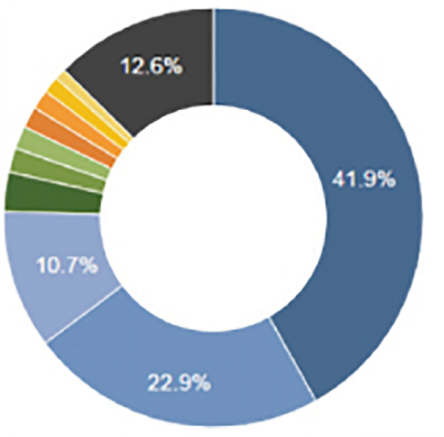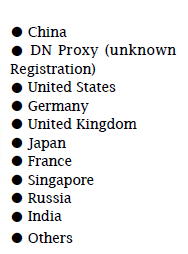Thinking on Current Trademark Law under Viewpoint of Enterprises
Zhou Liguo, Director of Intellectual Property Department of Tencent
Tencent has thousands of products and its product l ine is also very long, including a lot of direct consumer-oriented products. Therefore, it is not uncommon that the company faces infringement and squatting of its trademarks.In recent years, Tencent ’s internationalization speed is getting faster and faster and its scale is getting larger and larger, and meanwhile, many excellent products have been gone global. In many countries, Tencent has also obtained relevant trademark registrations.
I. Trademark Issue from Corporate Standpoint
Our view on the problems is different from that of those legal professionals if we consider them from the perspective of an enterprise or a brand owner. First of all, our “definition” for the malicious squatting of trademarks is that any trademark application behavior riding on others’ goodwill is regarded as a squatting act of trademarks. Specifically, the extension of this “definition” is very large, the scope of trademark squatting is not limited to the trademark itself. It seems to us that they are trademark squatters even if they only squat the characters, maps in the games or characters in the movies. In addition, we do not take into consideration the issue of similarity of products or services.
As a brand owner, we have great expectations for well-known trademarks. However, for many years, whether for prosecution or litigation, it has failed to meet the expectations of well-known trademark owners.Hence, we hope that the relevant system can improve the protection of well-known trademarks.
In our opinions, the renewal speed of the Differentiation of Similar Commodities and Services in the eyes of brand owners has always been unable to keep up with the times–although the legal provisions are often lagging behind the real society, this backwardness will inevitably cause some problems.For example, among category 0901 in the Differentiation of Similar Commodities and Services, the computer keyboards and computer game software are similar products; among category 4105, the providing of Karaoke services and tourguide services is similar to that of online game services in the computer network. However, we believe that the consumers can in reality completely distinguish these commodities and services. Hence, they do not also have the possibility of commodity approximation or service approximation.
We feel deeply troubled by the fact that the trademarks have been rejected due to the contradictions between such similar system and the reality. The lagging defect of this system has led to the waste of a large amount of resources, and particularly in the context of such a large amount of trademark applications in China, the Trademark Office of the State Administration for Industry & Commerce (Trademark Office of SAIC), the Trademark Review and Adjudication Board (TRAB) and the courts have to carry tremendous workload, while any enterprise that encounters the aforesaid situation has also to submit some refusal to administrative process or judicial review. In fact, both sides are wasting the valuable energy and time for such an institutional lag. Taking the blockchain (a current popular concept) for example, how shall the classification of their commodities be defined when declaring the relevant trademarks of the blockchain products? At present, it can only be self-defined by us. Obviously, the development speed of the society has now far outgrown what is defined by the laws.
Nowadays, the craziness of trademark squatting has exceeded the imagination of the people. When the news about the “trademark squatting of Golden Arches” spread over the network, I did not believe it at the very beginning. So I checked it in the official website of the Trademark Office of SAIC. I found out that there were really more than a thousand of application records for the “Golden Arches” after McDonald’s China was renamed in October, 2017.It is conceivable that, how crazy the trademark squatting has been developed in China!
As a close relative of the trademarks, the situation in the domain name field can also reflect the crazy status quo of trademark squatting. The chart below gives the distribution of global applicants for the recent new top-level domains.The chart shows that 41.9 % of the publicly available domain applicants are from China; 22.9 % has hidden their information, but we estimate that half of them are also from China.In other words, half of the applicants for new top-level domains in the world are Chinese enterprises or individuals.


What is even more troubling is that the battleground of trademark squatting is not confined to China.We play with China’s trademark squatters in China; in foreign countries, the vast majority of the squatters for Chinese brands are also Chinese, and we have also to play against the squatters for China’s trademarks. After the gameplaying in the trademark field, we have to continue to play in the domain name field. This shows that the issue of trademark squatting is becoming increasingly complicated and tricky.
Is there a way for enterprises to deal with this? In reality, there are few ways for enterprises. The most common method is to suppress the squatting by relying on the application. This reason is simple because the cost of trademark application is the lowest. In fact, the enterprises do not want to apply for so many trademarks. But the squatters will apply if they do not apply. They will spend considerable time and financial costs when they go to defend their rights and revocations. In contrast, it is better to apply in large quantities by themselves in advance. Moreover, the enterprises have also to carry out a large number of trademark monitoring. They can only fight against the squatters to the end because it is impossible for the well-known brand enterprises to yield to the trademark squatters if they find that their rights and interests are infringed.
II. Suggestions and Appeals of Enterprises for Amendment of the Trademark Law
As an enterprise, we have the following suggestions for the amendment of the Trademark Law based on our own circumstances and appeals:
1) Regarding the well-known trademark sys tem: we hope that the well-known trademark system can keep pace with the times. For example, Provisions on Recognition and Protection of Well-Known Trademarks (this is of course an extension of the Trademark Law), in which, the identification regulation of “three years and five years” can be amended appropriately because the development speed of Internet products is now very amazing, such as, Wechat, Glory of the King, DiDi, Douyin, and other products, can be popular throughout the country in a year. In contrast, the identification regulation of “three years and five years” appears to be too long. Furthermore, in this “big IP” era, the surrounding products and services are becoming wider and wider, and their cross-border is very fast and wide-spread. In this regard, the concept of “similar commodities or services” can also be appropriately expanded in the amendment of the Trademark Law.
2) Regarding the merchandising rights: We hope that some targeted and adaptive amendments can be made separately to the merchandizing right s in the amendment of the Trademark Law in order to effectively fit the demand of brand enterprises to safeguard the legal rights.
3) Regarding the cancellation procedure for no use of trademarks in three years: as an enterprise, we have experienced a lot of the cases for “cancellation procedure for no use of trademarks in three years” in recent two years. We often cancel others, and vise versa. A case of “cancellation procedure for no use of trademarks in three years”may take many years to bear fruit, and thus the cost of litigation is very big for both the canceller and the canceled person. Hence, we hope that the trial period of the cases of “cancellation procedure for no use of trademarks in three years” in the future will be reduced. Moreover, the Supreme People’s Court has some special regulations on t h e rules o f evidences for the trademarks not used for three years, but in actual judicial practices, there are still some strange evidences that make both litigant parties at a loss as to what to do. Therefore, we hope that the rules of evidences for the cases of “cancellation procedure for no use of trademarks in three years” can also be further refined in the subsequent amendments of the Trademark Law.
4 ) Regarding the fee of trademark application: at present, China’s trademark application fees are likely to be at the lowest level in the world. For enterprises, we hope that China’s trademark application fees can no longer be reduced, allowing the trademark application to return to a rational and serious civil legal act and avoid the investors’ speculation of grabbing money.
5) Regarding the renewal of trademarks: for this issue, our concern is on whether the renewal interval of trademarks can be shortened or the evidences can be provided by stages. In China, for both an enterprise and a product, it is uncertain whether it can last for ten years. Therefore, for some zombie trademarks, there is no need to wait for the expiration of ten years to solve the problem. China can shorten the protection t ime of the trademarks. For example, the registrant is required to submit evidence of use or confirm its willingness to continue the use every five years, and then it shall be renewed.
6) Regarding the Trademark Data: the further disclosure of the trademark data is a call of the trademark’s own attributes.The amount of trademark data is now extremely big. We need more updated and more comprehensive t radema rk da t a t o help the trademark applicants analyze and defend their rights to avoid various blind-area problems.
7) Regarding trademark legal interference procedings: for opposition and validity and other procedings, we hope to include some punitive rules to them so as to increase the squatting cost of the trademark squatters.
8) Regarding office actions at the examination stage of trademarks: we believe that we can learn the office actions systems of the United Kingdom, the United States, France and other countries at the examination stage of trademarks. The official authority and the applicants can fully communicate with each other on some simple issues rather than rebuting them to push the issues to the TRAB and the court for resolution. This approach can effectively reduce the rejection rate and increase the probability and speed of the applicants to obtain trademark registration.
9) Regarding the time limit for rejection review: we believe that the current 15-day time limit for rejection review shall be extended. This is because, for some enterprises, especially overseas enterprises, it will take a few months for notarization and certification of some evidences and it is obviously difficult to complete the notarization and certification within 15 days.
10) Regarding the coexistence of trademarks: the number of trademark applications in China i s nowadays too large while the number of Chinese words is very limited. Hence, there will inevitably be more and more problems of trademark coexistence in China, especially among large enterprises .Sometimes, enterprises do not want to engage in the legal confrontation because of the same name of trademarks. It is also a good choice if the coexistence of two trademarks can be achieved.
The above are some of my perceptive suggestions as a representative of an enterprise and I hope that they can help this amendment of the Trademark Law from a business perspective.








